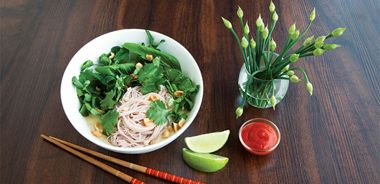Shan Noodle Soup

While still under the culinary radar, cuisine from Myanmar (formerly Burma) is poised to become the next “hot” Asian culinary trend. Chickpea flour gives this traditional soup from the Shan people of Myanmar a velvety thick texture that is a wonderful change of pace from other Asian soups.
Be sure to place some Asian chili sauce on the table for those who like a fiery kick. If available, chopped Chinese chives are a great addition as well.
8 oz (225 g) brown rice vermicelli noodles
1 cup (250 mL) chickpea (garbanzo) flour
2 Tbsp (30 mL) coconut sugar or other raw-style sugar
1/4 tsp (1 mL) salt
1/4 tsp (1 mL) red chili flakes
2 tsp (10 mL) grapeseed oil or peanut oil
2 shallots, chopped
3 garlic cloves, minced
4 cups (1 L) low-sodium vegetable broth
4 cups (1 L) chopped Asian greens, such as pea tendrils, watercress, baby bok choy, and/or Chinese broccoli
1/3 cup (80 mL) chopped roasted unsalted peanuts
1/4 cup (60 mL) cilantro
1 lime, sliced into wedges
Prepare noodles according to package directions. Drain and set aside.
Place chickpea flour, sugar, salt, chili flakes, and 1 1/2 cups (350 mL) water in blender and blend until smooth.
Heat oil in large saucepan over medium heat. Add shallot and garlic; cook for 2 minutes, stirring often. Add broth and 1 1/2 cups (350 mL) water to pan and bring to a boil. Reduce heat to medium and slowly pour in chickpea mixture while stirring. Heat for 5 minutes, stirring very often to prevent mixture from sticking to bottom of pan. Stir in additional water or broth if you want a thinner consistency.
Divide noodles and greens among serving bowls and pour chickpea soup over top. Garnish with peanuts and cilantro. Serve with lime wedges.
Serves 6.
Each serving contains: 314 calories; 8 g protein; 7 g total fat (1 g sat. fat, 0 g trans fat); 53 g total carbohydrates (8 g sugars, 4 g fibre); 313 mg sodium
Source: "Oodles of Noodles", alive #377, March 2014





